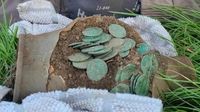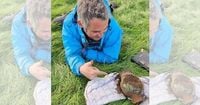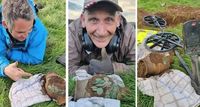On a windswept field in North Wales, a discovery that could rewrite Welsh archaeological history has come to light: up to 15,000 Roman coins, unearthed by a devoted metal detectorist and his friend, in what experts are calling the largest hoard of its kind ever found in Wales.
David Moss, 36, from Cheshire, describes the moment as nothing short of surreal. “A rainbow appeared minutes before the signal was found. I couldn’t believe it. I had goosebumps,” Moss told BBC. The find, made in August 2025, took place after six and a half hours of painstaking excavation with his friend Ian Nicholson. They uncovered two clay pots, each brimming with coins, just over 20 inches below the surface.
Moss, who has been metal detecting for nearly a decade and has previously discovered about 2,700 Roman coins, said this find was on a different scale altogether. “It truly felt like a sign, a rainbow came out, and persistence paid off,” he shared with Greek Reporter. But with the thrill of discovery came an unexpected anxiety. Fearing theft, Moss spent three nights sleeping in his car with the coins before he delivered them to the National Museum Cardiff for safekeeping. “I just didn’t want to leave it out of my sight,” he admitted, echoing a sentiment any treasure hunter might understand.
The hoard is now secured at the National Museum Cardiff, where curators and numismatic experts are beginning the meticulous process of cleaning, cataloguing, and analyzing the coins. The assessment is expected to be completed next year, in 2026. Curators will be looking for mint marks, imperial portraits, and other clues to help date the coins and shed light on why they were buried.
Anthony Halse, chairman of the South Wales and Monmouthshire Numismatic Society, believes this discovery could surpass all previous Roman coin hoards in Wales. “I would have thought that it was a person’s wealth that could be in a section of the army,” Halse told BBC. He speculated that the coins might have belonged to Roman soldiers who buried their wealth for safekeeping, perhaps during a time of crisis or upheaval. “They’ll clean them and, since it’s such a large hoard, they will apply to the British Museum to see if they can keep them. Then they’ll go to the board and make the finder an offer. He’ll get half the money and the landowner will get the other half.”
The precise location of the find remains a closely guarded secret, with Moss describing the area only as “virtually untouched,” a landscape rich with artifacts from the times of druids, Vikings, and Romans alike. “It’s an area that I’ll be interested in for the rest of my life,” Moss said, his fascination with the site undimmed by the attention his discovery has attracted.
The size of the hoard is remarkable by any measure. Previous notable Welsh finds include nearly 6,000 coins at Sully in the Vale of Glamorgan in 2008, and about 10,000 coins near Chepstow in the 1990s. But this latest discovery, estimated at between 10,000 and 15,000 coins, could well eclipse them all. For context, the largest Roman coin hoard ever found in Britain was unearthed in Somerset in 2010, comprising more than 50,000 coins valued at over £320,000.
Such hoards are often the product of turbulent times. According to BBC, coin hoards were typically buried deliberately, sometimes as offerings to the gods, but more often as a way to safeguard wealth during periods of conflict or uncertainty. Many were never recovered by their original owners, leaving them for future generations to discover, centuries later.
Yet, for all the romance of such discoveries, there are strict rules governing how treasure must be handled in the UK. The Treasure Act 1996 requires anyone who finds treasure in Wales to report it to a Finds Liaison Officer within 14 days of discovery or of realizing its potential significance. Treasure is defined as any object at least 300 years old with at least 10% precious metal, or as a group of at least two coins over 300 years old meeting the same criteria. After reporting, the find is assessed by experts, and a coroner’s inquest determines whether it qualifies as treasure. If a museum wishes to acquire the hoard, the Treasure Valuation Committee arranges an independent valuation, and any reward is split between the finder and the landowner.
Failure to comply with these regulations can have serious consequences. Experts cited by BBC and Greek Reporter referenced the cautionary tale of Layton Davies, a Welshman who in 2015 was jailed for concealing his discovery of £3 million worth of Viking coins in Herefordshire. Davies failed to report the hoard and tried to sell items privately, ultimately resulting in jail time and a fine. The message to would-be detectorists is clear: transparency and adherence to the law are paramount.
Moss, for his part, has followed the rules to the letter, notifying the landowner and authorities promptly. He even received a plastic box from the landowner to store the coins before making the four-hour drive to Cardiff. His actions have been praised by museum officials and numismatists alike, as the hoard’s safe recovery now allows for detailed study and, potentially, public display.
The process from discovery to display is a lengthy one. After initial reporting, finds are examined and catalogued by museum staff. If the coins meet the legal definition of treasure, museums can express interest in acquiring them. The Treasure Valuation Committee then recommends a fair market value, with the Secretary of State for the Department for Culture, Media and Sport making the final decision on reward distribution. If any party—finder, landowner, or occupier—acts in bad faith, such as by trespassing or attempting to hide the find, their share of the reward may be reduced or denied altogether.
Experts warn against cleaning or tampering with ancient coins, as this can cause irreversible damage. Instead, finders are advised to carefully record the location and circumstances of discovery and to contact the relevant authorities as soon as possible.
For Moss, the experience has been life-changing. “It’s something I’ll never forget,” he told BBC. “To think those coins have lain buried for nearly two thousand years—it’s just incredible.”
The full assessment of the hoard is expected to be completed in 2026, with historians and archaeologists eagerly awaiting the results. The hope is that the coins will not only enrich museum collections but also shed new light on Roman life—and perhaps the moments of crisis that led someone, long ago, to bury such a fortune beneath the Welsh soil.
As the coins await their turn under the conservator’s brush, their story serves as a reminder of the rich, layered history beneath our feet—and the thrill that still awaits those with patience, curiosity, and a little bit of luck.






